
Alexander Heinle
Alex is a marketer at Zavvy. On this blog, he mainly shares insights gained from discussions with selected experts and from helping our customers set up and improve their onboarding or learning programs.

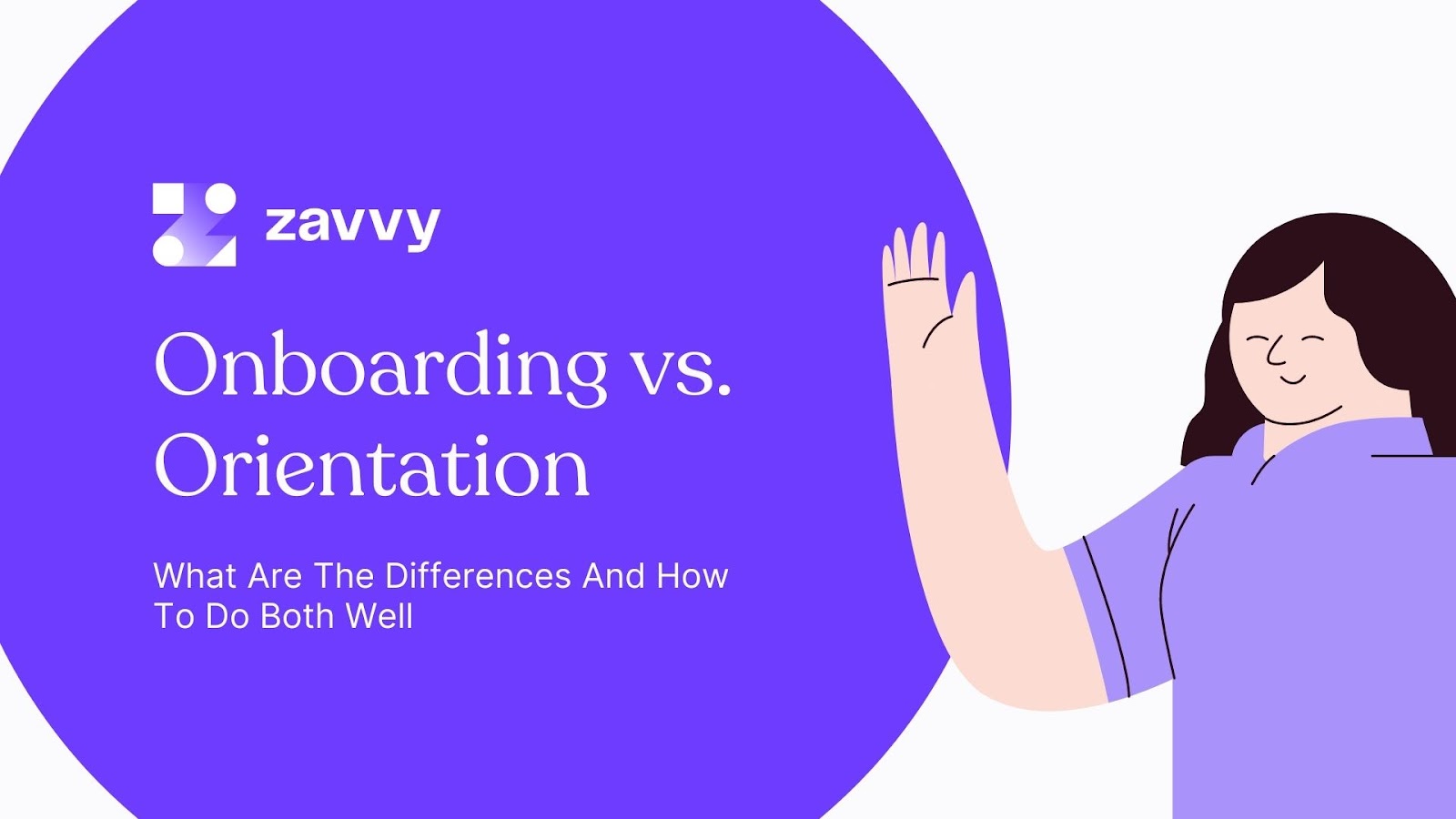
After putting in the hours and effort to hire a new employee, retaining them is a top priority. The first few weeks of a new hire’s tenure are crucial to their perception of your company.
In People Operations, it’s key to understand the difference in orientation vs. onboarding and maximize both to prepare new hires for success.
Together with our curators, we have created a library of actionable digital marketing resources. Personalized to your team's needs.
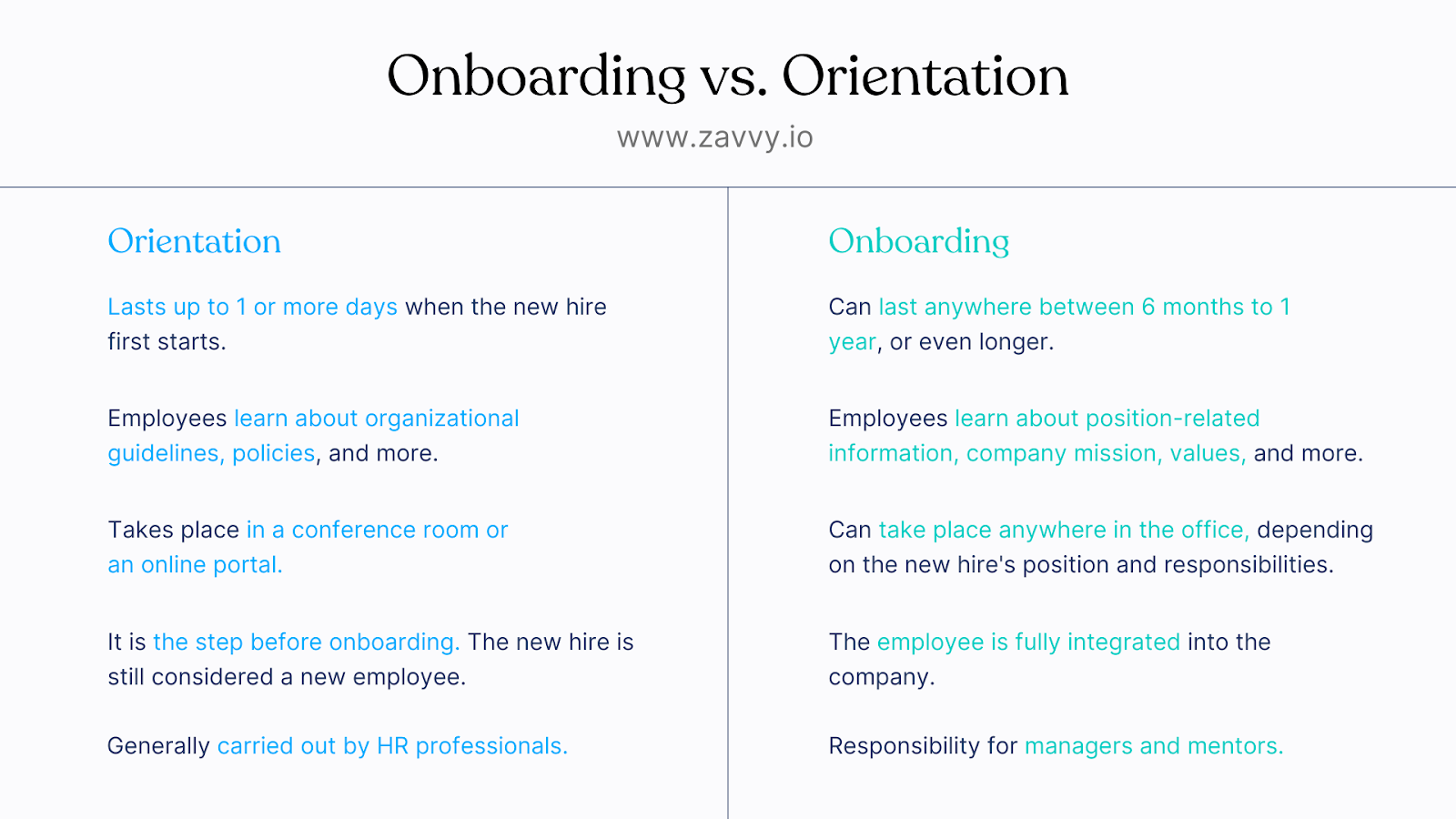
Orientation is a general welcome for new hires. It is a one-time event and occurs at the beginning of an employee’s time at a company. Employee orientation often involves
Onboarding is a long-term process designed to set up an employee for success in their specific role and department. It can involve
Orientation is just one part of onboarding. An effective HR strategy includes both, leveraging each for the benefit of everyone on your team.
There is only one chance to make a first impression. Yes, you brought new hires into your company. But the glance they got during the interview process pales in comparison to their first days as an employee.
This is the moment they decide if their preconceived notions about a job line up with reality, and that can make or break their experience. Orientation and onboarding are key moments that determine if a new hire will stay on your team, or move on to another opportunity.
Think of induction as a brief introduction to orientation. Induction can be as simple as a brochure given to new hires about the company to pre-orientation paperwork.
If your team is remote or back in the office, induction could be a welcome package sent to your new hires’ addresses with a company information packet inside, a helpful precursor to orientation day.
The sequence most companies take is induction first, followed by orientation, then the rest of onboarding. Induction and orientation are considered part of the larger onboarding process.
Onboarding can last up to a year, but orientation typically lasts a day few days to a week. The key aspects of orientation, such as company presentations and opportunities for new hires to ask questions about their new job, can be covered in a relatively short time frame.
Onboarding, on the other hand, is an ongoing process that occurs as new hires are actively working in their role. During their onboarding experience, new hires take on projects, participate in their own presentations, and are already adding their expertise to the team.
Because orientation and onboarding must be tailored to your company and new hires’ specific roles, their lengths will vary from firm to firm.
Orientation may be just one part of the entire onboarding process, but it is a very important part to get right. A new hire’s first impression of a workplace can make or break their thoughts about a career there.
You want them to feel welcome, appreciated, and excited for a future applying their skills to your mission.
Orientation typically includes:
Any general information that new hires need to know as they start their tenure at a company belongs in orientation. If it’s more specific to their role and would be irrelevant to another new hire, hold off on it until later in the onboarding process.
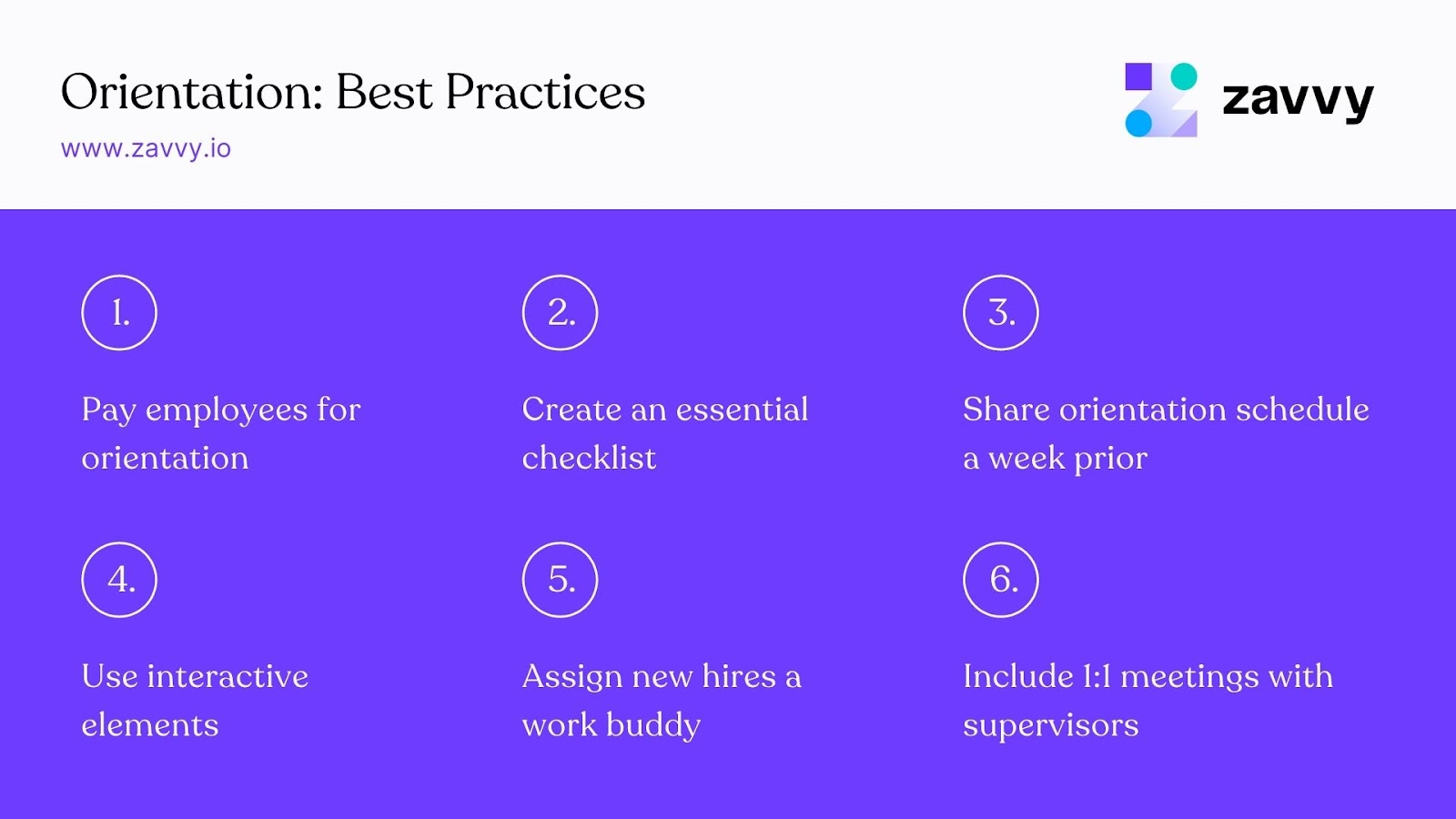
As a seasoned HR professional, you know that orientation is a day you can’t get wrong. Orientation practices are always evolving and will continue to improve, but some aspects of successful orientations stand the test of time.
Here are some orientation best practices:
The ideal orientation day is an energetic intro that has new hires excited for their future on the job. Once your team has brought in the candidates you won over, it’s time for job-specific preliminary training via onboarding.
Onboarding is an in-depth, personalized, long-term process at the beginning of an employee’s tenure at a company. Because it is more specialized than orientation and induction, team managers take a more active role in onboarding new hires.
While new hires complete onboarding, they are participating actively in team meetings, presentations, and even taking ownership for projects.
Part of the onboarding process is a space to grow and get preliminary feedback on the skills a new hire brings to their team. Encourage new hires to show where they shine as they complete the onboarding process, giving actionable feedback when needed.
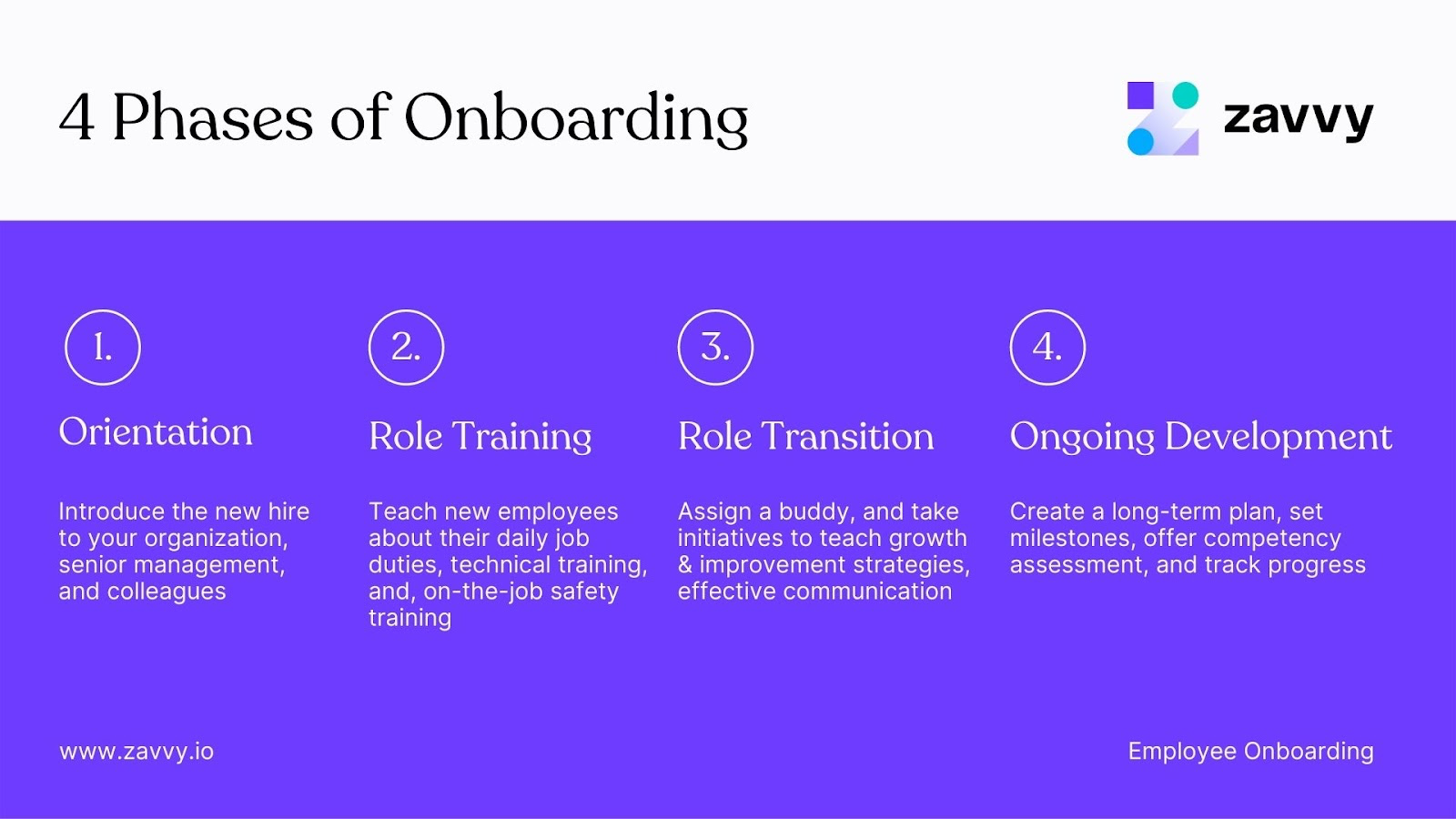
Many companies prefer to break down their onboarding process into 4 distinct phases.
Orientation – Phase 1 begins the minute a new hire accepts their offer. This time period is sensitive, because candidates may change their minds about their decision to work at your company. It’s imperative to use this time to excite new hires about their first day at the office and be sure their decision was a good one.
Because a new hire may be finishing up exit processes at their former employer, give them a fair amount of time to complete any induction paperwork for orientation day. New hires likely won’t know anything about your organization, so tell them what they need to know about working with you and deliver this information succinctly.
Role training – Role-specific training is one of the most important phases of onboarding. Its purpose is to fill any gaps between what a new hire already knows and what they need to be effective at their new job.
Without a formal training process involving supervisors, team members, and new hires together, a new employee can feel lost and insignificant in the broader organization. To avoid new hire dissatisfaction and encourage healthy productivity, show them you care about them and are glad they’re here.
Role transition – Phase 3 of the onboarding process segues a new hire to a role they feel secure and confident in, with tasks they are equipped to do after training.
Pair new hires with a mentor or work buddy to help them smoothly transition to a regular team member. This is the time to communicate expectations and standards for the new hire’s position to avoid disappointments.
Ongoing development – The final phase of onboarding is a long-term plan for employees to flourish in their new role.
A lack of career development is one of the main reasons employees leave one workplace for another. A clear development plan can make all the difference between a productive employee and a disgruntled one.
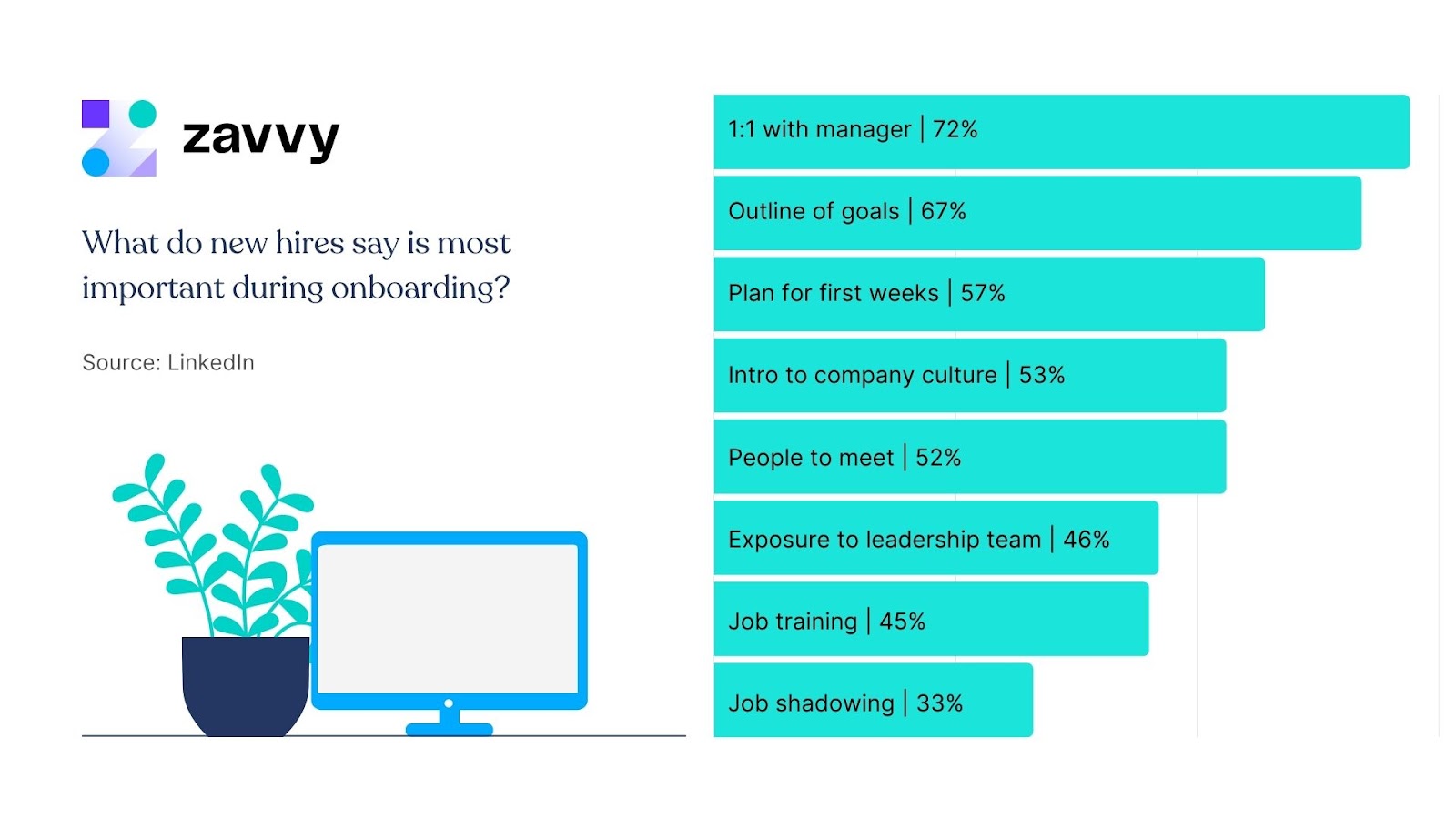
When designing an effective onboarding program, the opinions of new hires are the most valuable information to know.
According to a LinkedIn study, Inside the Mind of Today’s Candidate, 72% of respondents said 1-on-1 time with a direct manager was most useful to their onboarding process.
Although many companies spend good money on welcome gifts, only 17% of respondents considered them “very useful.”
Survey respondents instead ranked five factors consistently as the most useful in onboarding:
New hires want actionable information, a realistic picture of their place on a team, and an idea of who you are as a company. This allows them to determine where they fit and how they can be successful in the long-run as an employee.
An high-performing HR team like yours has a never-ending amount of tasks to keep up with when onboarding new hires.
Zavvy’s onboarding software allows you to set up an unforgettable onboarding experience with ease. Automate the busy work so you can do what’s important.
Find out how to run awesome onboarding in minutes with Zavvy or book a free live demo today.
Upskill your team every week with the best contents and personalized recommendations.

After putting in the hours and effort to hire a new employee, retaining them is a top priority. The first few weeks of a new hire’s tenure are crucial to their perception of your company.
In People Operations, it’s key to understand the difference in orientation vs. onboarding and maximize both to prepare new hires for success.
Get a demo!
We'll be happy to show you around and answer all your questions.
Trusted by innovative companies



We'll be happy to show you around, answer your questions, or arrange a free trial.
Erhalten Sie eine kostenlose Demo unserer Onboarding-Software.
Vertraut von



Your Training & Development Strategy - Solved in 1 Tool.
Trusted by innovative companies



We'll be happy to show you around, answer your questions, or arrange a free trial.
Learn how Zavvy helps you drive performance, development, and engagement.
Trusted by innovative companies



We'll be happy to show you around, answer your questions, or arrange a free trial.
We'll be happy to show you around and answer all your questions.
Trusted by innovative companies



We'll be happy to show you around, answer your questions, or arrange a free trial.
Gerne zeigen wir Ihnen ganz unverbindlich unsere Plattform im Detail.
Vertraut von modernen Unternehmen



Get a demo!
We'll be happy to show you around and answer all your questions.
Trusted by innovative companies



We'll be happy to show you around, answer your questions, or arrange a free trial.
Erhalten Sie eine kostenlose Demo unserer Software für Mitarbeiterenwicklung und Training.
Moderne Unternehmen
setzen auf Zavvy


